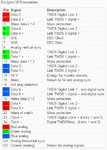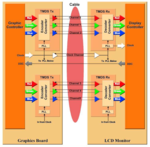Alper özel
Member level 1
- Joined
- Feb 28, 2015
- Messages
- 40
- Helped
- 0
- Reputation
- 0
- Reaction score
- 0
- Trophy points
- 6
- Location
- Turkey / Scotland
- Activity points
- 487
I did not know whereelse to put this but PC Programming and interfacing seems the best fit for this topic. So;
Facts:

For right eye, shutter shuts the left eye and display shows the image for right eye and then for the left eye, shutter shuts the right eye and opens up the left eye and display shows for the left eye and on and on goes like this. This is how 3-D visual is done with shutter.
Now, there are several 3-D systems out there in the market. The most popular one is lightboost setup:

As the lightboost released on the market many monitor vendors also released +120 Hz monitors with lightboost support(such as VG248QE the most popular one).
Before I reveal my question, I feel like I have to explain technical details of DVI dual link and LCD driver a little bit. There are some missing parts of them which I could not understand.
This is DVI dual link pinouts:

I found this on the adress: http://www.alciro.org/alciro/conectores_26/conector-DVI-interfaz-visual-digital_269_en.htm
explained as follows:
The DVI connector is divided mainly into three areas:
TMDS. (Transition Minimized Differential Signaling) or Transition Minimized Differential Signal similar to communication systems balanced. Marked on the figure by the brown color has four twisted pair cables one for each primary color video red, green and blue. Each two pairs have a mass of specific protection marked in dark brown. The video signal is synchronized with a pair of twisted wires in light brown line has its own mass. With a video link can transmit high-definition HDTV signal (1920 × 1080) at 60 Hz (139 MHz) for better definitions and better refresh the DVI connector includes a second link in combination with the former provides resolutions higher than HDTV HDTV (1920 × 1080) at 85 Hz (2 × 126 MHz) or WQXGA (2560 × 1600) at 60 Hz (2 × 135 MHz), among others.
Pug & Play. Marked in blue has a number of lines that highlight the DDC (Display Data Channel), serial connection with pin I2C Bus SDA (data) and SCL (clock). Are used to detect and display settings when connecting to a computer.
Analog. Analog system, marked in green features a pin (pin) for each RGB primary color red, green and blue analog sync with the digital connector makes it compatible with the analog system, reaching a bandwidth of 400 MHz

So, 3-D visualization method seems not that hard. Send the pixel datas for Left eye than send the datas for Right eye and on... Communication protocol also seems not that hard! You simply send the datas not encapsulated as you can see below:

As you see, with DVI, we send datas bit by bit and the LCD driver of the monitor decodes received data. So, my question is this: Why do I need lightboost(Or any other 3-D vision product)? What lightboost(3-D stereo feature of it) actually does? Why don't we just use the same communication with monitor and simply send preconstructed Left and Right pixel datas to the monitor and then it decodes the data and do the same job as in lightboost?
To open up my question a bit more, I have to indicate where my question actually relies. It is between the graphic board and the monitor. You see, lightboost requires both graphic board and monitor lightboost compitable. What does it mean? In lightboost 3-D mode, does communication between graphic board and the monitor change? If so, why? Why doesn't the graphic card first construct 3-D content and send them in the same way before? For instance, when try to use lightboost on some other machine with old graphic cards, I get the warning that the graphic card does not have 3-D stereo feature. If 3-D content is already prepeared(like 3-D movie or anmation), why can't I use any graphic card(which can drive 120 Hz 1080p) to send them to the monitor? After all, the method looks simple:
(1)drive pixels with left eye data, then strobe backlight
(2)drive pixels with right eye data, then strobe backlight
then it goes like 1,2,1,2,1,2,1,2,1,2,1,2,1,2,1,2....
Why do I need 3-D stereo? What 3-D stereo feature does? How it effects the communication between the monitor and the graph card? Are there primarily differences in the hardware structures of graphic cards which have 3-D stereo feature and which don't have? If there are, what are they? I firstly, wonder about these. I could not reach any detailed documentation about the topic.
Secondly, say it has to be done in that way, communication between the monitor and the G.board(via DVI dual link) has to change in 3-D mode. Then why is that?What changes? In what way they manage to switch to 3-D mode? I firstly, want to know the reason for this and secondly, what is the method for this.
Thank you already.
Facts:
- We know that a system needs high data transfer speed if it works with +120 Hz refresh rate and +1080p resolution(This mostly requires DVI dual link).
- We know that in a 3-D system with shutter, the method is to flash for Right and Left eye arbitrary.

For right eye, shutter shuts the left eye and display shows the image for right eye and then for the left eye, shutter shuts the right eye and opens up the left eye and display shows for the left eye and on and on goes like this. This is how 3-D visual is done with shutter.
Now, there are several 3-D systems out there in the market. The most popular one is lightboost setup:
As the lightboost released on the market many monitor vendors also released +120 Hz monitors with lightboost support(such as VG248QE the most popular one).
Before I reveal my question, I feel like I have to explain technical details of DVI dual link and LCD driver a little bit. There are some missing parts of them which I could not understand.
This is DVI dual link pinouts:

I found this on the adress: http://www.alciro.org/alciro/conectores_26/conector-DVI-interfaz-visual-digital_269_en.htm
explained as follows:
The DVI connector is divided mainly into three areas:
TMDS. (Transition Minimized Differential Signaling) or Transition Minimized Differential Signal similar to communication systems balanced. Marked on the figure by the brown color has four twisted pair cables one for each primary color video red, green and blue. Each two pairs have a mass of specific protection marked in dark brown. The video signal is synchronized with a pair of twisted wires in light brown line has its own mass. With a video link can transmit high-definition HDTV signal (1920 × 1080) at 60 Hz (139 MHz) for better definitions and better refresh the DVI connector includes a second link in combination with the former provides resolutions higher than HDTV HDTV (1920 × 1080) at 85 Hz (2 × 126 MHz) or WQXGA (2560 × 1600) at 60 Hz (2 × 135 MHz), among others.
Pug & Play. Marked in blue has a number of lines that highlight the DDC (Display Data Channel), serial connection with pin I2C Bus SDA (data) and SCL (clock). Are used to detect and display settings when connecting to a computer.
Analog. Analog system, marked in green features a pin (pin) for each RGB primary color red, green and blue analog sync with the digital connector makes it compatible with the analog system, reaching a bandwidth of 400 MHz

So, 3-D visualization method seems not that hard. Send the pixel datas for Left eye than send the datas for Right eye and on... Communication protocol also seems not that hard! You simply send the datas not encapsulated as you can see below:

As you see, with DVI, we send datas bit by bit and the LCD driver of the monitor decodes received data. So, my question is this: Why do I need lightboost(Or any other 3-D vision product)? What lightboost(3-D stereo feature of it) actually does? Why don't we just use the same communication with monitor and simply send preconstructed Left and Right pixel datas to the monitor and then it decodes the data and do the same job as in lightboost?
To open up my question a bit more, I have to indicate where my question actually relies. It is between the graphic board and the monitor. You see, lightboost requires both graphic board and monitor lightboost compitable. What does it mean? In lightboost 3-D mode, does communication between graphic board and the monitor change? If so, why? Why doesn't the graphic card first construct 3-D content and send them in the same way before? For instance, when try to use lightboost on some other machine with old graphic cards, I get the warning that the graphic card does not have 3-D stereo feature. If 3-D content is already prepeared(like 3-D movie or anmation), why can't I use any graphic card(which can drive 120 Hz 1080p) to send them to the monitor? After all, the method looks simple:
(1)drive pixels with left eye data, then strobe backlight
(2)drive pixels with right eye data, then strobe backlight
then it goes like 1,2,1,2,1,2,1,2,1,2,1,2,1,2,1,2....
Why do I need 3-D stereo? What 3-D stereo feature does? How it effects the communication between the monitor and the graph card? Are there primarily differences in the hardware structures of graphic cards which have 3-D stereo feature and which don't have? If there are, what are they? I firstly, wonder about these. I could not reach any detailed documentation about the topic.
Secondly, say it has to be done in that way, communication between the monitor and the G.board(via DVI dual link) has to change in 3-D mode. Then why is that?What changes? In what way they manage to switch to 3-D mode? I firstly, want to know the reason for this and secondly, what is the method for this.
Thank you already.